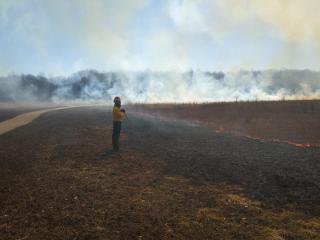Prescribed Fire at Portage Park District

Author: Bob Lange, Natural Areas Steward
Naturally occurring fires, often in combination with other disturbances, have always played a role in shaping the Earth’s plant communities and ecosystems. Many of the original vegetative communities on this planet occur, in part, due to fires. In general, most natural fires are caused by lightning strikes, with spontaneous combustion being another potential source of ignition. Prescribed fire, or controlled burning, is the practice of intentionally igniting fires in natural areas under a specific set of conditions to achieve a desired management objective. Prescribed fire has been used by humans in this country and worldwide for thousands of years. Native Americans utilized controlled burning to manage land for game, open areas for agriculture and to clear land for travel. Land managers continue using the practice today in efforts to restore and maintain ecological communities.
Locally, several land managing agencies routinely conduct prescribed fires. Most of this activity occurs in the fall or spring seasons. Many of these fires aim to manage open habitats like meadows and restored prairies. Spring fires tend to promote grass species and burning in the fall can increase populations of wildflowers. In either case, fires reduce the amount of woody species occurring in these open habitats, thus maintaining open, herbaceous stands. Fire speeds up the nutrient cycle, making nutrients available to plants more quickly, prompting a flush of vibrant growth. Often, these fires can be used to maintain suitable habitat for desired wildlife species. Increasing bare ground in meadows and prairies can improve mobility for ground nesting birds, for example. Recently, some agencies have started to burn woodland habitats in efforts to promote oak dominated forests. Oaks are typically more tolerant of fire, and prescribed burning can reduce the numbers of other intolerant species. Increased sunlight and reduced litter on the forest floor increase oak reproduction. There has also been a renewed interest in using fire to manage plant communities in wetland habitats, such as bogs and fens, where rare species are sometime suppressed by an overly abundant woody overstory. In some areas, prescribed fires are used in efforts to prevent the risk of high intensity wildfires by reducing the amount of fuel in forests in a controlled manner on a frequent basis.
Conducting a prescribed fire requires a great deal of planning and is highly dependent on weather conditions, timing and availability of resources. Planning the fire truly is a prescription. The amount of fuel, it’s moisture content and air temperature are some of the first factors in determining if conditions are right for controlled burning. Other factors that come into play include relative humidity, the number of days since rain, wind speed and direction and the atmospheric mixing height. The mixing height determines at which height above the Earth’s surface smoke from the fire will be dispersed. All these factors determine whether a controlled fire can be conducted safely and effectively with smoke dispersed in a manner that will not impair visibility or cause air quality issues. By observing current atmospheric and site conditions, it is possible to calculate fire intensity, flame height and the rate at which fire will spread throughout a burn unit. All fire prescriptions, or burn plans, must be developed and approved by an Ohio Certified Prescribed Fire Manager. This certification is granted and managed by the Ohio Department of Natural Resources Division of Forestry.
2019 marks the first year that prescribed fire has been employed to manage Portage Park District lands. Two burn units totaling over 13 acres were burned at Morgan Park on March 27. The fire was successful in meeting the objective of reducing the number of woody stems that had established in areas where we are managing for open herbaceous habitat. The Ohio Division of Natural Areas and Preserves, Hiram College, Western Reserve Land Conservancy and Geauga Park District all helped with the burn. Over the last decade or so, this group of agencies has steadily developed into a valuable partnership that we all rely on to manage our prescribed fires. Aside from making burns successful in the field, it is the sharing of information and experiences among the group that is perhaps the most important benefit of working together. In addition to the burn at Morgan Park, the group teamed up this spring to complete prescribed fires at Mantua Bog State Nature Preserve, Hiram College’s James H. Barrow Field Station and at Geauga Park District’s Eldon Russell Park and Swine Creek Reservation.

